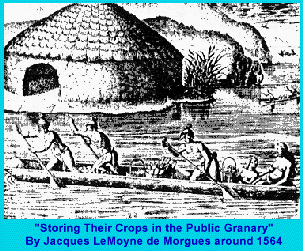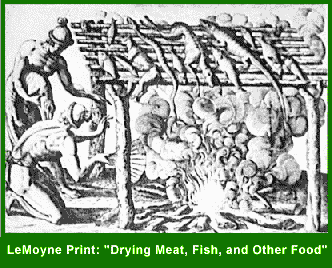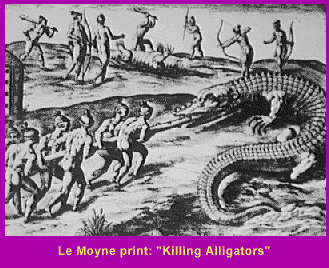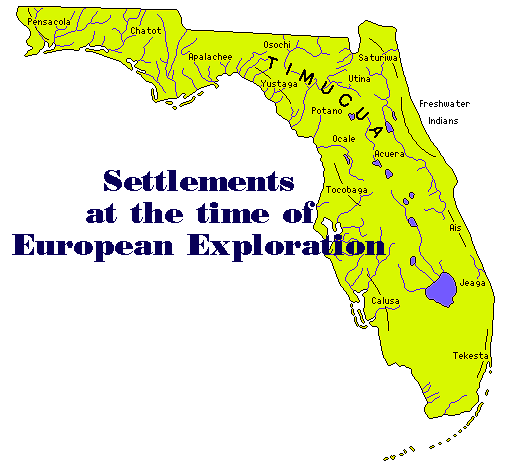16th Century Settlements
Hundreds of thousands of Indians already called Florida home when Europeans first arrived in the early 16th century. But it did not take long for the ensuing wars, slave trade and European diseases to nearly wipe out the aboriginal population.
When European ships first landed on Florida in the 16th century, the area was well populated. Indians of the Timucua, Apalachee, Ais, Tekesta and Calusa were farming rich lands in the north -- growing corn, beans and squash -- and fishing or hunting for most of their food in the south.

Locations near reliable food sources with fresh water, comfortable microclimate and high, dry ground made good habitat for these Indians. Fresh and brackish bodies of water supplied steady sources of fish and shellfish, while fertile soils allowed farming to prosper.
Florida's aboriginal population of about 100,000 was nearly decimated by exposure to deadly diseases that were brought to Florida by European settlers. Smallpox, measles, influenza, even the common cold were deadly to Indians.
Of course, wars with Spain and other Europeans contributed to the near extinction of early Indians of Florida.
The slave trade -- Florida Indians were taken as slaves as early as 1520 -- also helped kill off the aboriginal population.

The Apalachee
One of the most powerful and influential native groups of Florida was the Apalachee. At the time Europeans began arriving in America, the Apalachee controlled the fertile area near the Tallahassee hills between the Ochlockonee and Aucilla rivers. The fertile clay and loam soils of the hills supported the heaviest, most concentrated aboriginal population in the state.
The first Spaniards to explore Florida extensively were drawn to this same region. Panfilo de Narvaez journeyed there from Tampa Bay in 1528. Hernando de Soto wintered there from October 1539 until early March 1540.
Searching for gold, Narvaez and his expedition moved through swampy unpopulated flatwoods until they reached the Apalachee area, near present-day Tallahassee. The Apalachee "loomed big and naked, and from a distance looked like giants. They were handsomely proportioned, lean, agile, and strong," he wrote.
Eleven years later, one of de Soto's men remarked on the abundance of corn and other food in all the Apalachee villages.
When the Europeans arrived, the Apalachee lived in somewhat permanent villages, relying heavily on agriculture for their subsistence. Controlling the territory between the Aucilla and land some distance west beyond the Ochlockonee River, they were a distinct group, politically and culturally, recognized as such both by themselves and other Indian groups far to the south.
As a result of the fierce and determined hostility that the Apalachee manifested toward the first Spanish intrusions into their territory in the second quarter of the 16th century, Spain made no additional attempts to contact them until early in the next century.
Timucuan
Neighboring the Apalachee to the east were the Timucua, composed of at least 15 separate tribes sharing a common language. More is known about the Saturiwa than any other Timucuan group. They were encountered by the French in 1562 and immortalized in the drawings of Jacques Le Moyne de Morgues. Each Timuicuan village had its own leader who was under the jurisdiction of a head chief who exacted tribute.

The general name Timucuan was used by the Spaniards for all the native peoples who occupied north Florida east of the territory of the Apalachee. The Timucua were composed of a number of autonomous provinces that were hostile to one another at time when the first Europeans arrived. Among the important divisions in mission times were the Saltwater Timucua (Saturiwa and Mocamo), Fresh Water, Potano, Utina and Yustaga. The Saturiwa Indians used the name Timucua, spelled thimogna, to designate specfically the Utina Indians living between the St. Johns and the Suwannee rivers. In the early 17th century, Spaniards also used the name in this restrictive sense.
South Florida
Less is known about the early Indians of South Florida. The best known group is the Calusa, whose vast domain was ruled by a single chief. Although lacking agriculture, the Calusa developed elaborate political, social and trade networks. They were also expert wood carvers, and the many ceremonial items recovered from a Calusa site on Key Marco display great artistic skill. The Calusa lived around Charlotte Harbor just north of present-day Naples and around the mouth of the Caloosahatchie River in South Florida.
Arguably the most complex precontact culture in South Florida existed inland, in the Lake Okeechobee basin. These people not only had a sophisticated political and social organization, but they also grew corn. Striking similarities between their form of maize horticulture and that originating in the savannas of northern South America. This has led some scholars to suggest that ancient people of South American migrated north to South Florida through the Antilles islands of the Caribbean.

